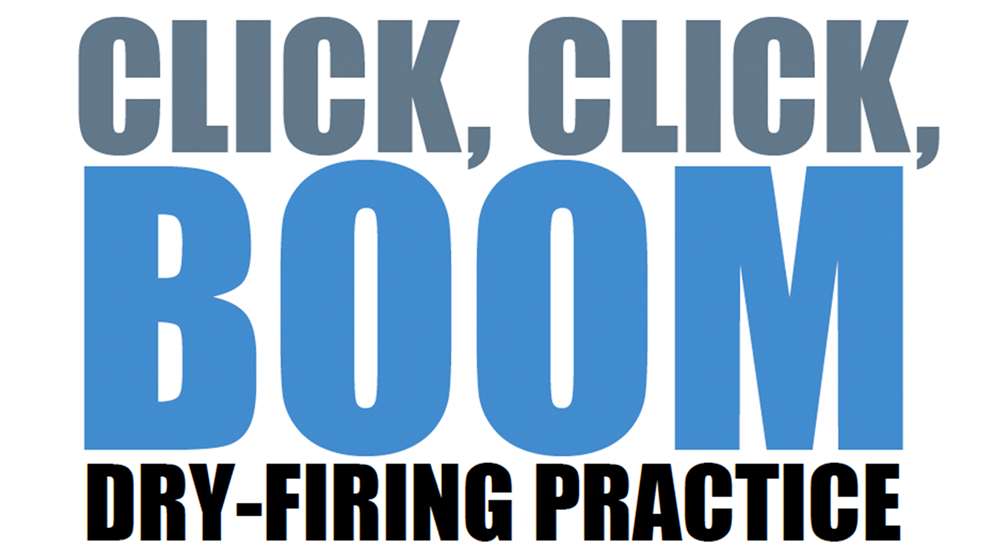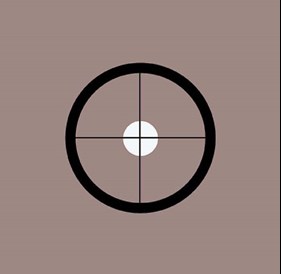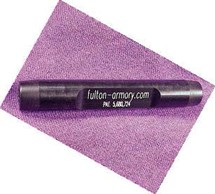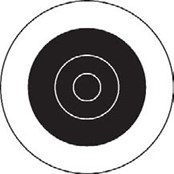
Dry-firing defined: It’s shooting with no ammunition. Cock the gun, hold on the target and break the trigger. It’s a simulation. First, then, is safety! Make double daggone sure there is no ammunition in the gun (of course) and also that there is none nearby. No loaded magazines in the vicinity. I’ve heard stories of people who reloaded their handguns, in this instance, after a dry-firing session and then decided to snap just one more for the road. Yikes. Don’t trust memory.
As a training vehicle, dry-firing is convenient, for one; costs nothing, for two; and, most importantly, allows essentially unlimited freedom for experimentation. We hope that produces tangible influences on tournament day performance. For the more experienced and accomplished competitor, dry-firing usually becomes all but exclusively limited to rehearsal for the standing position. That’s in no way to say that everyone won’t benefit from dry-firing exercises in sitting and prone. Dry-firing can help every position.
There are two elemental approaches to dry-firing, and I’ll offer some thoughts on each. The main way, and the focus of this article, is to use it as a means for technical or mechanical improvement. Another, though, is as a way to rehearse a course-of-fire.
The Rehearsal
Many believe that the more “real” we can make dry-firing the better. I agree, and then I don’t. If the idea is to duplicate the event, that means setting up the firing point, running a timer, adorning all personal gear, positioning all items, and so on. I think that is a great exercise for all shooters to run, and especially newer entrants.
One of the preeminent, and therefore important, aspects of learning how to shoot NRA High Power Rifle (in particular) are all the things to remember. There are indeed many, and it’s all those things that aren’t “shooting” that get in the way. A checklist, either on paper or in memory, has to become a habit. Overlooking just about any step or check may result in a wasted string.
Efficiency and economy are keys to easier shooting. Learning to set, and then reset, the firing point for each event is tantamount to success. Let’s set up a timer, then, and rehearse the three-minute prep period, over and over and over. This sort of dry-firing exercise, and I call it that although I guess it has nothing to do with actually dry-firing the gun, is invaluable in helping you learn to position your kit, learn where to stow necessary items, and, essentially, how to come to the line prepared. As suggested, it can progress by running through the event checklist and learning how to get ready for the string just as quickly and easily as you can.
Technical and Mechanical Improvement
Now, on to the real essence of dry-firing, which are technical and mechanical improvements to “the self.” When this is the focus, I don’t think it matters even a little bit to attempt to duplicate tournament conditions. Part of the point and advantage of dry-firing is elimination of distractions. We can then see and sense things when we’re in our little dry-firing cocoons that may be obscured during live-fire. I’m not saying that no one can tune in as keenly outdoors with a loaded gun, but can say there are always more distractions in the sunlight and wind. The point is to see it dry-firing, and then experience it again at the range. That’s the idea.
Wear your coat, glove, hat, glasses and ear protection (if you normally wear them). I learned the very hard way to give that advice. I used to shoot my air rifle without wearing my coat or any other gear but a glove. My idea was to develop a standing position that relied strongly on skeletal support. (My idea also was to stay cool and reduce the set up time for practice.) As a result, I got to where I could shoot really good targets just in a t-shirt. I worked and worked (and worked) on this. Well, then I put my coat on and my ear muffs and found out that I couldn’t duplicate my t-shirt position! Oops. I learned a lot but overlooked the future application of why it was that I was learning.
The first and foremost conviction necessary to make dry-firing “work” is a commitment to two things: Observation and natural point of aim. By observation I mean close observation of front sight location and movement. No matter what, that’s the “it.” You must learn to connect front sight location at the instant you are aware of the audible “click” of the hammer or striker fall, not just when the trigger breaks. There are a few milliseconds in the interim (lock time). It won’t take long to develop the skill of calling shots with more precision and realism during dry-firing with this as a goal. It’s how a shooter learns to separate what should be and what actually is. If you are perfectly aware of the front sight location on the aiming black at the strike, that by itself may improve follow through because you are “holding on” just a little longer. It’s a small thing, but many small things happen in the time it takes for the round to fire. No matter what your last name, everyone’s gun is moving. It’s here that the shooter learns to watch closely for movement.
Dry-firing allows a shooter to discover perfection in their natural point of aim. Natural point of aim (let’s cut it to “NPA”) is a drilled and preached fundamental by every instructor or authority I know. But dry-firing gives the opportunity to honestly get in tune with it. At least three things you’ll learn are:
- NPA is a finite point, not an area;
- It has two components, vertical and horizontal; and
- It changes! Even among the very best standing shooters, it’s not likely to start and stop with the exact same body orientation throughout a string.
A huge key to NPA is watching for front sight movement just before or just as the trigger breaks. That’s easy to see in dry-firing and more difficult with a loaded gun. I’m not exactly sure why NPA sometimes “reveals” itself in this moment, but I’m far from alone in making that observation.
Experimenting
Dry-firing is the time to run experiments. These can be major changes, like a different holding or gripping method, or small things, like nudging the head a quarter-inch farther forward. Everything and anything that’s not part of the “routine” is an experiment. Dry-firing gives you the opportunity to really tune in to just exactly what your routine is. David Tubb calls it the “control” position. When you make a change to that control position, do it one thing at a time. Otherwise feedback might be less accurately reliable.
Sometimes simply changing your grip on the gun, altering the width of your stance—anything major, will require smaller changes elsewhere to the control position. However, the advice still stands: One thing at a time. Decide that the big change is worthwhile (even if only for more testing) before incorporating more changes along with it.
If you’re trying to teach yourself when you’re tired, you’re learning only how to perform when you’re tired (and you probably won’t be performing very well).
Don’t be afraid to try anything. Use your imagination. As long as you have a place to return to, any side trip is a no-harm, no-foul experience. Try canting the rifle inward a little more, changing the position of your right foot, gripping more (or less) with the little finger, loosening or tightening a strap on the coat—all in the name of a consistent NPA. You name it.
And do by all means name it. Write everything down! Get a notebook and keep it handy and don’t end a training session without making a few notes. Write down what you tried and then what happened. Add on ideas for next time. If you don’t do this, in my mind, you’re honestly not going to get from it what you could. Don’t trust memory. It’s right then and now that you are in tune with your performance and have the keenest sense of feedback.
How Long is Too Long?
Don’t over-stay a session. There’s a time to quit, and that’s so decidedly for your own good. Those among us who tend to be, well, a little hard on ourselves, don’t like quitting until they “get it.” After a point, which varies with us all, we experience a physical and mental breakdown, more or less, where we then are running experiments and experiences through a tired mind and body. Then we’re learning how to perform in a condition or circumstance we will not likely experience at a tournament. I’ve seen this in other sports: Hitting too many golf balls, throwing too many pitches, running too many laps on a racetrack. Take a good break and come back to it but don’t tax yourself. If you want to build strength and endurance, do exercises where that is the focus (not on-target performance). Hold the rifle to the point of exhaustion, just don’t drop the hammer! I think you’ll get more from lifting weights.
Speaking of exhaustion, and still considering the cautions just presented, find out how long you can hold on a shot attempt. This is important. Over-holding can kill an offhand score, just the same as “over-staring” can wreak havoc on a prone shot. Just hold and watch. Pay attention to sight movement, discover ways to keep it central, and then, mostly, see when it’s just done with until the next attempt. This is valuable. It’s hard sometimes on a record shot not to continue to hold beyond the point you should have brought the gun down.
Accessories and Drills
Protect Your Gun
Will dry-firing hurt my gun? Depends, but very likely not. Every centerfire bolt-action rifle “we” use can be dry-fired endlessly with no damage done. I’ve known of M1s and M1As breaking firing pins, but never had it happen myself, and further don’t know that dry-firing contributed any more than live-fire. If you are at all worried, use a “snap-cap,” which is a cartridge duplicate that provides a cushion. Smallbore rifle people have different opinions about them. The fear is peening the area around the chamber. Ruger actually encourages dry-firing its 10/22 (so says my manual). Inserts like the Champion’s Choice TM15 are also available to cushion the blow, and even a spent cartridge case left in place will do the trick.
AR Re-Cocking
Here’s a handy device for AR15 shooters. This insert will let you re-cock a fallen hammer with only ¼ inch pull. One lets you keep the magazine in place and dry-fire to your heart’s content with less effort expended. It just slips inside the bolt carrier. One can be purchased from several stores including Fulton Armory and Champion’s Choice.
Holding Drills
I give Troy Lawton full credit for this one. It’s a great dry-firing drill to help funnel in the hold for pistol or off-hand rifle shooting. Watch closely during the most steady, consistent part of your hold on the target and establish or define that area.
Troy defines it as the diameter (group size) that would result if you pulled the trigger at any point during this holding duration. Get a blank piece of paper and trace a circle just a little smaller than that (use a compass for neatness’ sake). This is now your target. Make the circle either black or white depending on iron sights or optical sight (this exercise works best with an optical sight). Then systematically start making that circle smaller as practice sessions continue. Don’t get in a hurry but don’t cut yourself too much slack. Huge help.
Scale a target carefully for dry-firing. I can’t tell you exactly what diameter to make it, but a little math usually gets it pretty close. Due to varying aiming black appearances that result from distance outdoors, the one you train with dry-firing might need to be just a tad different size than calculations dictate.
Above is what I use from 20 feet. The aiming black area is 0.700 inches diameter to duplicate an NRA SR1 (200-yard target). That’s a little smaller than the calculation warrants. Place your target at a realistic height. Only visualization from experience at your local range will show you where it should be, and, mostly, it’s determined from the “feel” of the shooting position. Don’t feel like you’re pushing up or dropping down the gun.
Another “test” you may get something from is alternating dry-fire and live-fire at the range. As always, call each shot. See what you see, or don’t see. Yet another twist on this one is to have someone load the rifle for you (be safe), and not tell you when it’s empty or live. That is an exercise many will learn a lot from.
[Editor’s Note: Glen prepared this article using material from several books published by Zediker Publishing. He has worked professionally with some of the greatest shooters on the planet, as well as leading industry “insider” rifle builders, manufacturers, and proven authorities on gunsmithing, barrel making, parts design and handloading. He also earned his High Master classification in NRA High Power Rifle the hard way—using an AR15 Service Rifle. For information on his shooting sports books, visit www.zediker.com.]



































